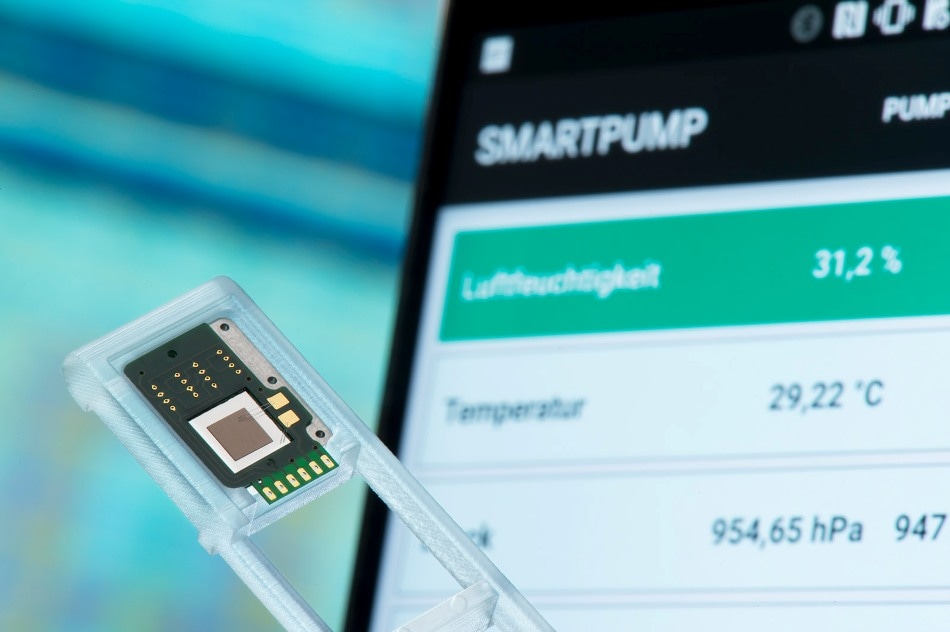Particulate matter is detrimental to the lungs and heart. Going forward, a smartphone developed with a built-in gas sensor can be used to notify regarding high exposure. In order to make the sensor respond swiftly and to generate precise measurements, Fraunhofer Scientists have designed a robust micro diaphragm pump for distributing atmospheric air to the sensor.
 The world’s smallest micromembrane pump measures just 25 square millimeters. CREDIT: Fraunhofer EMFT.
The world’s smallest micromembrane pump measures just 25 square millimeters. CREDIT: Fraunhofer EMFT.
Our smart pump measures only 25 square millimeters, making it the world’s smallest pump. That said, it still has a high compression ratio.
Dr. Martin Richter, Head of Micro Dosing Systems, the Fraunhofer Research Institution for Microsystems and Solid State Technologies EMFT, Munich
Richter and his colleagues applied the piezoelectric effect, where an applied electrical field is transformed into mechanical strain, to create pressure in the pump chamber. By modifying the voltage, the silicon membrane can be moved up and down. The silicon membrane allows the entry of atmospheric air through a valve, compresses the air inside the pump chamber and subsequently exhausts the air from the chamber.
Using tricks to increase pressure
Traditional micro diaphragm pumps that function by means of piezoelectric power produce comparatively low pressure with air. The imbalance in the piezo effect indicates that more space is needed inside the pump chamber in order to move the silicon membrane, consequently leading to a high dead volume, that is, a high residual gas volume inside the chamber. Richter and his colleagues devised a technique for minimizing the dead volume and increasing the suction capacity of the pump.
We use the piezo effect to specifically preload the diaphragm when assembling the piezoceramic. The advantage of this is that we no longer need a deep pump chamber. This trick enables us not only to build micropumps with high compression ratios but also to make them smaller in size.
Dr. Martin Richter, Head of Micro Dosing Systems, the Fraunhofer Research Institution for Microsystems and Solid State Technologies EMFT, Munich
Apart from the diaphragm, the pump chamber and the flap valves are also formed of monocrystalline silicon that is highly advantageous when compared to plastics and metals. One main reason is that the metalloid, also applied for producing computer chips and solar cells, is fatigue-free and flexible. The other reason is that the individual components of the pump can be very accurately etched from the silicon layer and then integrated together.
Yet, one of the major drawbacks of using silicon is its high cost; hence, the size of the pump has to be kept considerably small.
Our goal is to reduce the size of the pump to 10 square millimeters to make its mass production profitable. We are well on track to achieving this.
Dr. Martin Richter, Head of Micro Dosing Systems, the Fraunhofer Research Institution for Microsystems and Solid State Technologies EMFT, Munich
At present, the factor hindering the incorporation of gas sensors in smartphones is the very long reaction times of the sensors. This can be overcome by the smart pump as it can deliver air explicitly to the gas sensors, thereby minimizing the reaction time from a number of minutes to only 2 seconds. For example, apart from measuring the particulate matter concentration, the sensors can also sense if the air inside a room stinks and if a window has to be opened for ventilation.
In essence, the smartphone can also be powered to examine breath to measure the alcohol content, “However, this requires a high degree of measurement accuracy, which has not yet been achieved. Otherwise someone might decide to get behind the wheel of a car believing they measure just 0.3 per mille, when in fact they measure 0.9 per mille,” warned Richter.
Multiple applications
To cite an example, the micropump can also be applied in the field of medicine as either a medical patch to steadily administer pain killers or hormones in very small quantities, or an implant to assist in controlling pressure inside the eye during the treatment for glaucoma. Apart from that, the pump can also be used to deliver accurate doses of lubricant to machines. “This is an application that we are currently developing with a partner from industry.”
Richter and his colleagues were part of Fraunhofer’s Discover funding program that aids untraditional and original concepts, and are investigating about a supplementary application, namely, adding scent information to video and audio files. “A headset fitted with our smart pump could deliver precise doses of different scents close to the nose. The gaming industry has already expressed an interest in this.” Richter further stated that the smart pump will be a fascinating application for delivering very small and accurate doses of gases or liquids.
The Fraunhofer Future Foundation, with the goal of strengthening innovation and career prospects in Germany by licensing research outcomes to companies, funded the smart pump project.